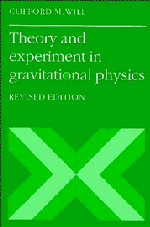Book contents
- Frontmatter
- Contents
- Preface to Revised Edition
- Preface to First Edition
- 1 Introduction
- 2 The Einstein Equivalence Principle and the Foundations of Gravitation Theory
- 3 Gravitation as a Geometric Phenomenon
- 4 The Parametrized Post-Newtonian Formalism
- 5 Post-Newtonian Limits of Alternative Metric Theories of Gravity
- 6 Equations of Motion in the PPN Formalism
- 7 The Classical Tests
- 8 Tests of the Strong Equivalence Principle
- 9 Other Tests of Post-Newtonian Gravity
- 10 Gravitational Radiation as a Tool for Testing Relativistic Gravity
- 11 Structure and Motion of Compact Objects in Alternative Theories of Gravity
- 12 The Binary Pulsar
- 13 Cosmological Tests
- 14 An Update
- References
- References to Chapter 14
- Index
12 - The Binary Pulsar
Published online by Cambridge University Press: 04 April 2011
- Frontmatter
- Contents
- Preface to Revised Edition
- Preface to First Edition
- 1 Introduction
- 2 The Einstein Equivalence Principle and the Foundations of Gravitation Theory
- 3 Gravitation as a Geometric Phenomenon
- 4 The Parametrized Post-Newtonian Formalism
- 5 Post-Newtonian Limits of Alternative Metric Theories of Gravity
- 6 Equations of Motion in the PPN Formalism
- 7 The Classical Tests
- 8 Tests of the Strong Equivalence Principle
- 9 Other Tests of Post-Newtonian Gravity
- 10 Gravitational Radiation as a Tool for Testing Relativistic Gravity
- 11 Structure and Motion of Compact Objects in Alternative Theories of Gravity
- 12 The Binary Pulsar
- 13 Cosmological Tests
- 14 An Update
- References
- References to Chapter 14
- Index
Summary
The summer of 1974 was an eventful one for Joseph Taylor and Russell Hulse. Using the Arecibo radio telescope in Puerto Rico, they had spent the time engaged in a systematic survey for new pulsars. During that survey, they detected 50 pulsars, of which 40 were not previously known, and made a variety of observations, including measurements of their pulse periods to an accuracy of one microsecond. But one of these pulsars, denoted PSR 1913 + 16, was peculiar: besides having a pulsation period of 59 ms – shorter than that of any known pulsar except the one in the Crab Nebula – it also defied any attempts to measure its period to ± 1 μs, by making “apparent period changes of up to 80 μs from day to day, and sometimes by as much as 8 μs over 5 minutes” (Hulse and Taylor, 1975). Such behavior is uncharacteristic of pulsars, and Hulse and Taylor rapidly concluded that the observed period changes were the result of Doppler shifts due to orbital motion of the pulsar about a companion. By the end of September, 1974, Hulse and Taylor had obtained an accurate “velocity curve” of this “single line spectroscopic binary.” The velocity curve was a plot of apparent period of the pulsar as a function of time.
- Type
- Chapter
- Information
- Theory and Experiment in Gravitational Physics , pp. 283 - 309Publisher: Cambridge University PressPrint publication year: 1993

